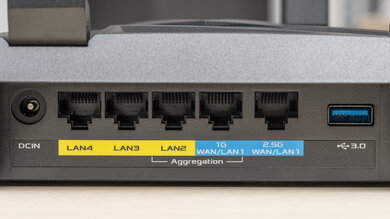The ASUS RT-AXE7800 is a tri-band Wi-Fi 6E router with 2.4GHz, 5GHz, and 6GHz bands. It has a unique hexagonal design with six external antennas that fold into the main body. It features a 2.5 Gbps networking port for a WAN or LAN connection and supports link aggregation, a feature that allows you to combine multiple network connections into a single, faster one. It has several useful software features, like ASUS' AiMesh, which allows you to use old ASUS routers as additional access points. It also has parental controls, built-in VPN support, and more.
Our Verdict
The ASUS RT-AXE7800 is a great router if you live in an apartment, condo, or single-story home. It provides excellent speeds across a single floor suitable for high-bitrate 4k video streaming and other high-bandwidth uses, whether you're in the same room or a completely different one. It has a 6GHz band and Dynamic Frequency Selection (DFS) support, so it can deliver faster speeds in noisy wireless environments like apartment buildings. It has a 2.5 Gbps networking port and a USB 3.0 port for local file sharing. It features an interesting design with a game-like aesthetic that might not fit your decor.
- Impressive top speeds.
- 2.5 Gbps WAN/LAN port.
- Wi-Fi 6E support.
The ASUS RT-AXE7800 is a very good router if you live in a multi-level house. It provides impressive speeds throughout the home that are suitable for high-bandwidth internet uses like 4k video streaming and quickly downloading large files. Since it's a standalone router and not a mesh system, it may leave some dead zones if you have a very large home with obstacles like masonry walls, but it's not an issue unless your home is substantial. Connectivity-wise, it has a 2.5 Gbps networking port and a USB 3.0 port for local file sharing. It features an interesting design with a game-like aesthetic that might not appeal to everyone.
- Impressive top speeds.
- Very good range performance.
- 2.5 Gbps WAN/LAN port.
- Wi-Fi 6E support.
- Standalone router that may have dead zones if you have a very large home.
The ASUS RT-AXE7800 delivers impressive speeds suitable for a gigabit internet connection. Its 6GHz band and Dynamic Frequency Selection (DFS) support mean it can avoid congested channels in noisy wireless environments for better speeds.
- Impressive top speeds.
- Wi-Fi 6E support.
The ASUS RT-AXE7800 has a very good range for a standalone router. While you might experience dead zones if you live in a very large home with concrete walls, it's compatible with other ASUS AiMesh devices to create a mesh network with an even better range.
- Very good range performance.
- Wi-Fi 6E support.
- Standalone router that may have dead zones if you have a very large home.
Changelog
- Updated Dec 16, 2025: We've added an MLO Implementation test for Test Bench 0.8.2! Read the changelog for more details.
- Updated May 01, 2025: We've converted this review to Test Bench 0.8.1. This includes a new test result for our Test Configuration box.
- Updated Jul 22, 2024: Review published.
Check Price
Differences Between Sizes And Variants
The ASUS AXE7800 doesn't have any variants. Here's a photo of our unit's label.
Popular Router Comparisons
The ASUS RT-AXE7800 is a tri-band Wi-Fi 6E router with 2.4GHz, 5GHz, and 6GHz bands. It has a 2.5 Gbps networking port and supports link aggregation, a feature that allows you to combine multiple network connections into a faster, single one.
This router performs similarly to other Wi-Fi 6E routers in its price range, like the TP-Link Archer AXE95, but its range performance isn't quite as good as a dedicated mesh system like in the eero Pro 6E.
If you're looking for more options, check out our recommendations for the best Wi-Fi routers, the best long-range routers, and the best routers for streaming.
The TP-Link Archer AXE75 and ASUS RT-AXE7800 are tri-band Wi-Fi 6E routers with DFS support, but the ASUS performs better and has a better selection of network ports. The ASUS delivers higher speeds over short and long ranges, whereas the TP-Link offers performance comparable to Wi-Fi 6 routers. The ASUS also provides a 2.5Gbps port that can be used for a WAN or LAN connection, while the TP-Link network ports cap out at 1Gbps. However, the ASUS model's aggressive design may not be to everyone's taste.
Test Results

This router's external antennas can fold into its main body for easier transportation. Here is a photo of the router.
You can either use the 2.5 Gbps port or the 1 Gbps port for WAN, depending on the speed of your internet plan. It also supports WAN and LAN link aggregation, a feature that combines multiple network connections into a single, faster one.
This is a standalone router, so the mesh satellite position line on this graph isn't applicable.
This is a standalone router, so the mesh satellite position line on this graph isn't applicable.
Wi-Fi 6E introduces a 6GHz band that takes advantage of less bandwidth congestion for faster speeds, but you'll need devices that support it to benefit from it fully.







